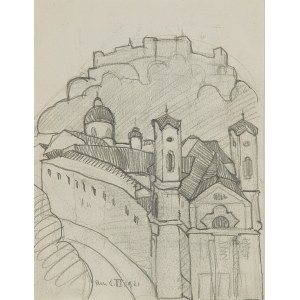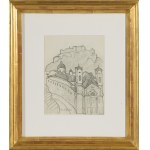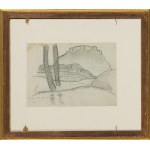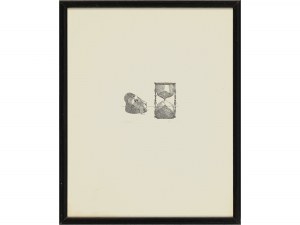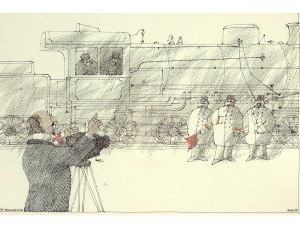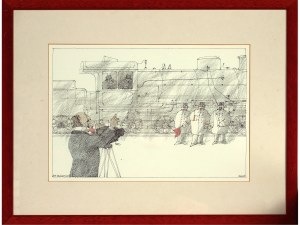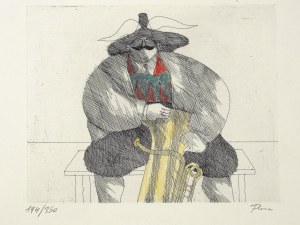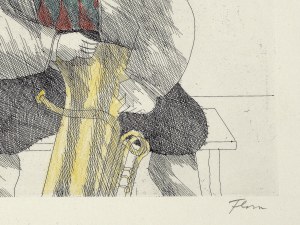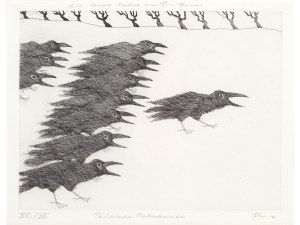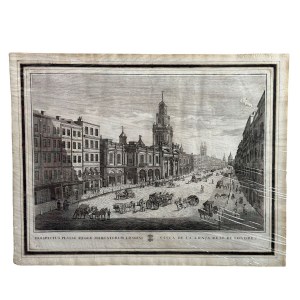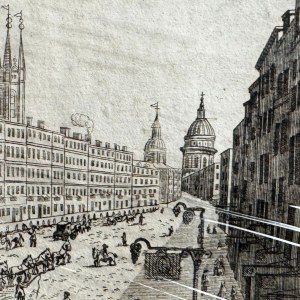HERBERT GURSCHNER*
(Innsbruck 1901 - 1975 London)
Fortress Hohensalzburg, 1921
pencil/paper, 26,2 x 18,5 cm
dated 8.VI.1921
verso further sketch of Fortress Hohensalzburg
Provenance: estate of the artist, Brenda Gurschner London, Fine Arts Widder Vienna
ESTIMATE °€ 1.500 - 2.500
START € 1.200
Austrian painter and stage designer of the 20th century especially the interwar period. A representative of Tyrolean modernism such as Artur Nikodem, Ernst Nepo, Wilhelm N. Prachensky, Hans Tyrol-Weber, etc. Stylistic development between Expressionism and New Objectivity. Nephew of the sculptors Emil and Gustav Gurschner. Attended the School of Arts and Crafts in Innsbruck and studied at the Academy of Fine Arts in Munich from 1918 to 1920. In 1920 he lived in Mühlau in Innsbruck, exhibited with the Mühlau Circle around Alfons Schnegg, Rudolf Lehnert and Ernst Nepo. Early 1920s landscapes and cityscapes from travels through Tyrol, Salzburg and Italy. 1924 Married the English noblewoman Dolores Cherwadsky-Damarkow, established contacts with London artist and collector circles. 1929 first exhibition at the London Fine Art Society. Contacts with aristocratic, diplomatic and business circles, exhibitions in London and New York. Marries his two Brenda Davidoff. Created landscapes, portraits and religious representations. Figurative approach comparable to Albin Egger-Lienz, Tyrolean landscape artists such as Alfons Walde and Oskar Mulley.
Gurschner's talent for painting became apparent at an early age. In 1918 he was accepted as the youngest student at the Academy in Munich. From 1920 he lived in the Mühlau district of Innsbruck and exhibited together with the other artists of the "Mühlau Circle", Nepo, Schnegg and Lehnert. From 1925 onwards he travelled extensively in Italy, Spain and France, exhibited at the Venice Biennale and had an acclaimed solo show at the London Fine Art Society in 1929. In 1931, the Tate Gallery purchased his "Annunciation". Gurschner lived from numerous portrait commissions and thus moved in aristocratic, diplomatic and business circles. In 1938 he went into exile in London, where he met his second wife Brenda. After the war, Gurschner turned to stage design and worked for Covent Garden Opera, the Globe and Hammersmith Theatre.
Natural landscapes and, in a broader sense, cityscapes form an important artistic challenge and a wide-ranging field of experimentation in Gurschner's work of the interwar period - whether in the form of a pencil drawing relying on contours, as a spontaneous watercolour or as a representative oil painting. Gurschner's city view focuses on the main historical sights of the picturesque city on the Salzach, which have always been part of every visitor's must-see programme: The Hohenfeste Salzburg, towering over the city, and the view from the Mönchsberg of the Altstatt with the cathedral and the baroque Kollegienkirche. Gurschner always chooses the picturesque angle of view and circles it, as it were: He surrounds the medieval fortress at the foot of the mountain with a defensive wall. He flanks the view of the Salzburg churches on both vertical sides with trees, which also function here as a classical repoussoir motif. Thus these city views appear to be pleasing vedute, which he perhaps wanted to transfer to the medium of printmaking. This is suggested by the clear disposition and the renunciation of too meticulous detail. Gurschner was perhaps also flirting here with the idea of using such views of Salzburg to find buyers for his art among the well-heeled audience of the still young Salzburg Festival, founded in 1920. Since the second Salzburg Festival took place from 2 to 23 August 1921, these drawings created in the run-up to the event could also be associated with this intention, especially since the festival city always scored points for its setting in one of the most beautiful landscapes in Europe. Already Hugo von Hofmannsthal, as co-founder of this Salzburg Festival, stated in 1919: "The Salzburg region is the heart of the heart of Europe. Central Europe has no more beautiful space - and it was precisely here that Mozart had to be born."
PLEASE NOTE:
The purchase price consists of the highest bid plus the buyer's premium, sales tax and, if applicable, the fee of artists resale rights. In the case of normal taxation (marked ° in the catalog), a premium of 24% is added to the highest bid. The mandatory sales tax of 13% is added to the sum of the highest bid and the buyer's premium. The buyer's premium amounts to 28% in case of differential taxation. The sales tax is included in the differential taxation.
Recently viewed
Please log in to see lots list
Favourites
Please log in to see lots list



